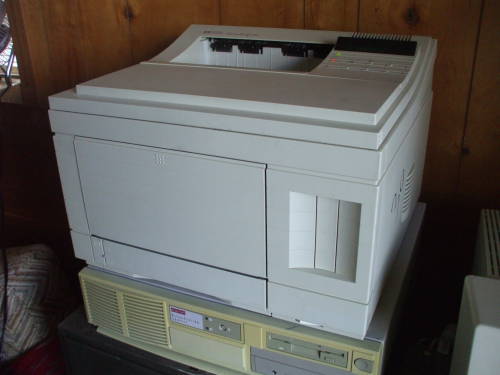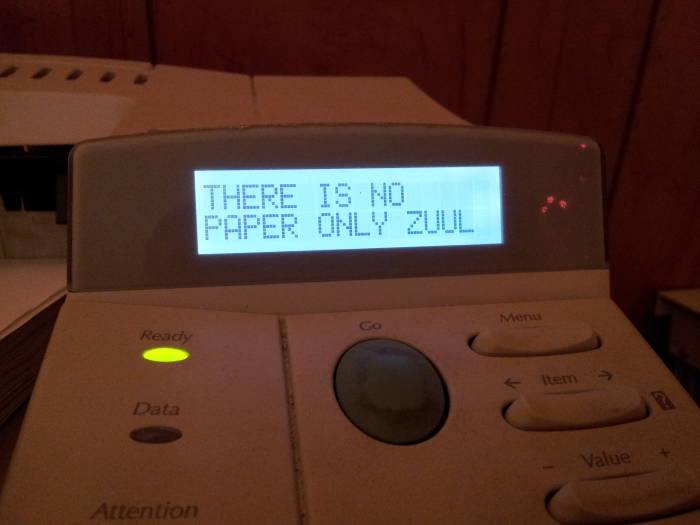
Change the Printer Ready Message
Printer Job Language
Let's say you want to put your printer into
Ghostbusters
mode, reporting THERE IS NO PAPER ONLY ZUUL
on its status panel.
Or whatever you want it to say other than
the boring READY.
Let's see how to change what appears on
the status panel display.
Hewlett-Packard developed PCL or the
Printer Command Language starting in
the mid 1980s.
PCL has become a de facto industry standard.
It started pretty simply as PCL 1,
but by 1995 PCL 6 was an object-oriented
page description language.
It's like Postscript from a parallel universe.
PJL or Printer Job Language
was introduced with the HP LaserJet IIIsi.
It was created as an extension of PCL, and like PCL
it has become a de facto standard that is
supported by most Postscript printers.
Well, kind of a standard.
HP has formally defined a set of PJL commands.
But an HP printer doesn't necessarily implement all of the
documented PJL commands, and printers from HP and other
manufacturers often implement proprietary commands
not in the official PJL definition.
PJL handles job control, switching between printer languages,
status querying, commands to manipulate the file system
within the printer, plus what we're interested in here,
the oddly named device attendance.

An HP LaserJet 4 printer eats a lot of electrical power. In the winter that simply provides useful heat. But in the summer, it might be a problem. Build a current-measuring box to see how much power your printer uses even when idle. Mine uses just 24 watts when truly idle, but about 790 watts when the fuser is running, meaning while it's printing and for 1-3 seconds from time to time during its "Ready" state.
First, let's use Nmap to run a port scan of the printer. I have replaced my vintage HP LaserJet 4 seen above with an HP LaserJet 4050tn, and I set up DNS records for it. The syntax is:
-sS |
Do a TCP SYN scan. |
-sV |
Grab banners and handshake with each service in an attempt to figure out its version. |
-O |
Try to figure out, or at least guess, the operating system. Note: That's dash-capital-Oh and not dash-zero. |
hplj4050tn |
Use the printer's IP address if you don't have DNS fully set up. |
[root@server src]# nmap -sS -sV -O hplj4050tn Starting Nmap 6.47 ( http://nmap.org ) at 2016-06-19 18:13 EDT Nmap scan report for hplj4050tn (10.1.1.234) Host is up (0.0021s latency). rDNS record for 10.1.1.234: hplj4050tn.cromwell-intl.com Not shown: 992 closed ports PORT STATE SERVICE VERSION 21/tcp open ftp HP JetDirect ftpd 23/tcp open telnet? 80/tcp open http HP Jetdirect httpd 280/tcp open http HP Jetdirect httpd 515/tcp open printer 631/tcp open http HP Jetdirect httpd 5120/tcp open tcpwrapped 9100/tcp open jetdirect? MAC Address: 00:30:C1:8B:D2:94 (Hewlett-packard) Device type: print server|printer Running: HP embedded OS CPE: cpe:/h:hp:jetdirect_2591a cpe:/h:hp:laserjet_4050 OS details: HP JetDirect 2591A print server, HP LaserJet 4050 printer Network Distance: 1 hop Service Info: Device: print server
Notice that the printer accepts connections at TCP port 9100, that's where we need to send our PJL commands!
Download the program
Here is a Unix-family shell script.
This works on my main Linux desktop and server,
and on my OpenBSD laptop,
and it should work on any Unix-family operating system
as long as you have the
nc
command installed.
If it isn't installed yet, it should be available as a
package.
If all else fails, you can build it from
source code.
Anyway, here is the script.
Notice the highlighted characters:
#!/bin/sh
# Check the user's syntax.
ERRMSG="Usage: $0 <IP address or hostname> \"RDYMSG\""
if [ "$#" -lt 2 -o "$1" == "-h" -o "$1" == "--help" ]
then
echo $ERRMSG
exit
fi
if [ "$#" -gt 2 ]
then
echo "You may have omitted quotes around your message."
echo ""
echo "$ERRMSG
exit
fi
# How you tell nc to hang up after the file is sent
# varies from Linux to OpenBSD.
if [ "$(uname -s)" == "Linux" ]
then
NCARGS="-q 0"
elif [ "$(uname -s)" == "OpenBSD" ]
then
NCARGS="-N"
else
echo "Sorry, OS $(uname -s) not supported"
exit
fi
# Store a PCL message in a file.
# Generate escape char with: Ctrl-V Ctrl-Esc
MSGFILE=/tmp/rdymsg-$$
cat > ${MSGFILE} << EOF
^[%-12345X@PJL RDYMSG DISPLAY="${2}"
^[%-12345X
EOF
# HP DirectJet talks on TCP port 9100.
# Send the file to that socket.
nc "${NCARGS}" $1 9100 < ${MSGFILE}
# Clean up
rm ${MSGFILE}
echo "Message sent, go check the printer display"
Or, just right-click and save this file
You can almost just copy and paste that script
into a file, make it executable with
chmod +x,
and use it.
But first you must change those two characters to Escape
characters.
Escape is ASCII 0x1b hexadecimal or 033 octal.
- Copy and paste the above into a file.
-
Use
vimto edit the file. -
Move the cursor to the first line now containing
literal
^[. -
Place the cursor on the
^character. Pressing0(zero) moves the cursor to the beginning of the line. -
Prepare to change two characters, the character under
the cursor and the one to its right, by pressing:
cl. -
Insert a literal Escape character by pressing
four keys:
Ctrl-V Ctrl-Escape -
Press
Escapefor good measure to make sure you are out of Insertion mode.
Now you're ready to change the "ready" message! Look at the display to see how many characters are available. This HP 4050tn has two rows of 16 characters for 25 or 32 characters total, and so we need to specify 5 spaces between "NO" and "PAPER":
$ hp-printer-msg hplj4050tn "THERE IS NO PAPER ONLY ZUUL"


Technical
Reference,
Part II PCL/PJL
Technical
Reference,
Part I PCL/PJL
Quick
Reference
Guide
Success!
Yes, this says THERE IS NO PAPER ONLY ZUUL
even when there is paper.
When the printer runs out of paper,
it tells me about that instead.
This makes sense to me.
Normally, Zuul rules the printer.
There are other messages, like OPMSG or Operator Message, and STMSG or Status Message, but sending one of them takes the printer offline.
The PCL/PJL Quick Reference Guide is 54 pages long, and Parts I and II of the PCL/PJL Technical Reference are 370 and 394 pages long, respectively.